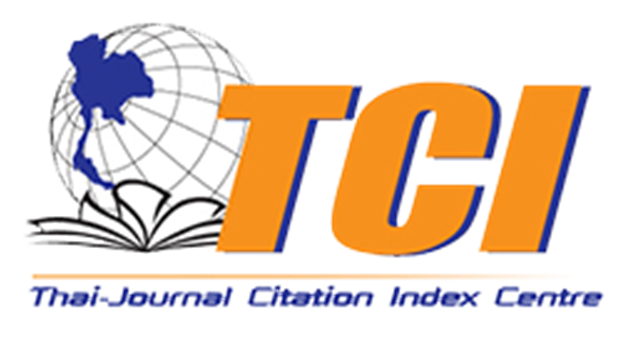Floor Mat produced from Tire Crumb Rubber and Polystyrene Wastes
การผลิตแผ่นปูพื้นสนามจากเศษยางล้อรถยนต์และขยะพอลิสไตรีน
Abstract
งานวิจัยนี้ศึกษาความเป็นไปได้ในการนำขยะบรรจุภัณฑ์พลาสติกและโฟมพอลิสไตรีนมาใช้เป็นสารเชื่อมประสานสำหรับการผลิตแผ่นปูพื้นสนามจากเศษยางล้อรถยนต์ เพื่อทดแทนการใช้สารเชื่อมประสานที่ใช้ในเชิงพาณิชย์ โดยทำการศึกษาอิทธิพลของอัตราส่วนระหว่างเศษยางล้อรถยนต์ต่อหินย่อย ปริมาณสารเชื่อมประสาน รวมถึงความหนาและความหนาแน่นของแผ่นปูพื้นสนามที่มีต่อสมบัติการต้านทานต่อแรงอัด สมบัติการต้านทานต่อแรงกระแทก และความสามารถในการซึมผ่านของน้ำ จากผลการทดสอบเบื้องต้น พบว่า ที่อัตราส่วนระหว่างเศษยางล้อรถยนต์ต่อหินย่อยเท่ากับ 75 ต่อ 25 เมื่อใช้ปริมาณสารเชื่อมประสานเท่ากับ 5 เปอร์เซ็นต์โดยปริมาตร ที่ความหนาแน่นเของแผ่นปูพื้นสนามเท่ากับ 0.9 กรัมต่อลูกบาศก์เซนติเมตร ให้สมบัติเชิงกลที่ดีที่สุด และแผ่นปูพื้นสนามที่ผลิตได้มีความสามารถในการซึมผ่านของน้ำได้ทุกกรณี นอกจากนี้งานวิจัยนี้ยังได้ใช้โปรแกรมคอมพิวเตอร์ Autodesk Fusion 360 ในการออกแบบและวิเคราะห์ความแข็งแรงของแผ่นปูพื้นสนาม เพื่อเปรียบเทียบกับผลการทดสอบจริง อีกทั้งยังถูกนำมาใช้ในการออกแบบแผ่นปูพื้นสนามที่มีลักษณะแนวเสริมแรงในรูปแบบที่แตกต่างกัน จากผลการวิเคราะห์โดยโปรแกรมคอมพิวเตอร์แสดงให้เห็นว่า ผลการวิเคราะห์ที่ได้สอดคล้องกับผลการทดสอบจริง และจากผลการศึกษาแนวทางการออกแบบแนวเสริมแรงของแผ่นปูพื้นสนามที่ให้ประสิทธิภาพสูงสุด ขึ้นอยู่กับรูปแบบ ความกว้าง และความสูงของแนวเสริมแรงที่ใช้สำหรับแผ่นปูพื้นสนาม ผลสำเร็จเบื้องต้นที่ได้จากงานวิจัยนี้ จะเป็นแนวทางที่สำคัญในการใช้ประโยชน์และลดปัญหาสิ่งแวดล้อมจากขยะพอลิสไตรีนและยางล้อรถยนต์ต่อไป
The objective of this work is to study the feasibility of using the disposal of polystyrene packaging plastic and foam as a binding agent for the floor mats, which is produced from recycled tire crumb rubber to replace commercial-grade binders. The influence of tire crumb rubber/aggregate ratio, binder content, bulk density, and product thickness on compressive strength, impact resistance, and water permeability are the main interesting factors. The preliminary results show that the best mechanical properties of tire crumb rubber floor mat can be obtained by using a crumb rubber/aggregate ratio of 75/25 mixed with 5.0 %V/V binder and the bulk density of floor mat is 0.9 g/cm3. Considering the water permeability, all the tire crumb rubber mat floors produced in this work are water - permeable. In this work, the computer program Autodesk Fusion 360 is utilized to design and analyze the strength of floor mats, and a comparison between the numerical and experimental results is carried out. Moreover, the various designs of rib patterns are examined. Good agreements between numerical and experimental results are found. For design purposes, to gain the highest strength-to-weight ratio, it is suggested that the rib pattern, rib width (W), and rib height (H) are important factors. The success of this work shows the high feasibility of utilizing polystyrene waste as a binding material to reclaim plastic wastes and tire rubbers and to reduce environmental problems.
Keywords
[1] J.A. Brydson, Plastics materials, 7th Ed., Butterworth-Heinemann, Oxford, 1999.
[2] K.G. Budinski and M.K. Budinski, Engineering material: Properties and selection, 6th Ed., Prentice Hall International Inc., NJ, 1999.
[3] J. Maris, S. Bourdon, J.M. Brossard, L. Cauret, L. Fontaine and V. Montembault, Mechanical recycling: compatibilization of mixed thermoplastic wastes, Polymer Degradation and Stability, 2018, 147, 245-266.
[4] Z. Zhongkun, Z. Denghua, S. Wentao, W. Linlin, Z. Jianbo, M. Hui, C. Lu, Y. Baohuai, Q. Yusheng and W. Changming, Study on mechanical properties of expanded polystyrene, American Journal of Civil Engineering, 2018, 6(1), 11-15.
[5] A. Salisu and S. Maigari, Polystyrene and its recycling: A review, Materials Science and Technology Society of Nigeria (MSN) Kaduna State, Proceeding, 2021, 195-203.
[6] J. Scheirs, Polymer recycling: science, technology and applications, John Wiley and Sons, NY, 1998.
[7] J.E. Mark, B. Erman and F.R. Eirich, Science and Technology of Rubber, 2nd Ed., Academic Press, NY, 1994.
[8] H. Chittella, L.W. Yoon, S. Ramarad and Z.W. Lai, Rubber waste management: A review on methods, mechanism, and prospects, Polymer Degradation and Stability, 2021, 194, 109761.
[9] A. Singh, S.N. Spak, E.A. Stone, J. Downard, R.L. Bullard, M. Pooley, P.A. Kostle, M.W. Mainprize, M.D. Wichman, T.M. Peters, D. Beardsley and C.O. Stanier, Uncontrolled combustion of shredded tires in a landfill—Part 2: population exposure, public health response, and an air quality index for urban fires, Atmospheric Environment, 2015, 104, 273–283.
[10] S. Ramarad, M. Khalid, C.T. Ratnam, A.L. Chuah and W. Rashmi, Waste tire rubber in polymer blends: A review on the evolution, properties and future, Progress in Materials Science, 2015, 72, 100-140.
[11] S. Kaewjang, Development of floor blocks from natural rubber and waste EPDM, Master’s Thesis, Faculty of Engineering, Prince of Songkla University, 2009. (in Thai)
[12] W. Deepanya and K. Suweero, Development of low cost natural rubber floor tile mixed with fine ethylene vinyl acetate plastic waste, Thesis, Department of Civil Engineering, Faculty of Engineering, Rajamangala University of Technology Thanyaburi, 2018. (in Thai)
[13] K. Suweero and P. Khamput, Development of interlocking concrete paving block product mixed with colored polyethylene terephthalate plastic bottle from post-consumer waste, Journal of Engineering RMUTT, 2020, 18, 81-89. (in Thai)
[14] A.R. Tarrer and V. Wagh, The effect of the physical and chemical characteristics of the aggregate on bonding, Strategic Highway Research Program, National Research Council, Washington DC, 1991.
[15] W.F. Smith, Principles of Materials Science and Engineering, 3rd Ed., McGraw-Hill series in Material Science and Engineering, NY, 1996.
DOI: 10.14416/j.ind.tech.2025.04.008
Refbacks
- There are currently no refbacks.






